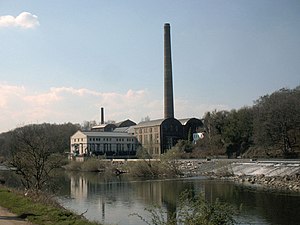Horster Mühle hydroelectric power station
| Horster Mühle hydroelectric power station | ||
|---|---|---|
| Hydroelectric power station Horster Mühle 2005 - general view from the east | ||
| location | ||
|
|
||
| Coordinates | 51 ° 25 '46 " N , 7 ° 6' 30" E | |
| country | Germany | |
| place | eat | |
| Waters | Dysentery | |
| power plant | ||
| owner | Franz Rudolph | |
| technology | ||
| Others | ||
The Horster Mühle is now a hydropower plant on the Ruhr in the Horst district of Essen . It belongs to the route of industrial culture .
About 300 meters further upstream from today's power station there was a mill that was first mentioned in a document in 1319. It belonged to the Lords of Horst . They owned lands from the Maas to the Sauerland . The mechanical engineer Franz Dinnendahl (* 1775; † 1826) and his brother Johann were born as sons of the miller on the Horster mill. Today a plaque commemorates this industrial pioneer in mining. The mill was taken over in 1840 by the Essen industrialist Friedrich Ludwig Niemann , who had a villa built as a residence nearby.
In 1910 the entrepreneur Wilhelm Vogelsang (* 1877; † 1939) bought the mill, the Hörster field and the surrounding area, Horst and the residence, today's Villa Vogelsang, from the Dammer bankruptcy . He built several factory buildings in brick architecture. The chimney of the carbide factory still preserved today contains light-colored stone bands and the lettering W. Vogelsang . Vogelsang also founded the new Wohlverwahrt colliery (closed in 1962) further above the facility. A building from 1915 is still preserved from the former colliery. Vogelsang did not join the Carbide Syndicate , a European cartel , and had to shut down the factory in 1932. However, the power plant remained in operation until it was shut down in 1971 (after a crown wheel broke ). The new mill is located in what is now the western part of the factory. It was operated as an oil, fruit and blue mill. The blue ( Thénards blue ) was broken from cobalt that came from the Hesper Valley on Lake Baldeney . It was used, among other things, to dye the slave smocks for Carolina .
The building contractor Franz Rudolph bought the facility in 1985 for a symbolic price of DM 1 and invested around DM 17 million in the listed building. Since 1989 the power plant has been supplying electricity to the RWE network again . Around 2,500 households can be supplied with electricity from this power plant in an environmentally friendly manner. The Horst lock is located on the opposite bank of the Ruhr .
Web links
- Horster Mühle Memorial (PDF; 1.57 MB)
- Description of all locations on this themed route as part of the Route of Industrial Culture
- Presentation of the Horster mill in the "Library of Factual Stories" by Armin Maiwald







